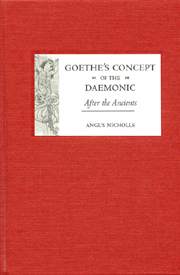Book contents
- Frontmatter
- Contents
- Editions and Abbreviations
- Acknowledgments
- Introduction
- 1 The Ancients and Their Daemons
- 2 The Daemonic in the Philosophy of the Sturm und Drang: Hamann and Herder
- 3 Romanticism and Unlimited Subjectivity: “Mahomets Gesang”
- 4 Werther: The Pathology of an Aesthetic Idea
- 5 Kantian Science and the Limits of Subjectivity
- 6 Schelling, Naturphilosophie, and “Mächtiges Überraschen”
- 7 After the Ancients: Dichtung und Wahrheit and “Urworte. Orphisch”
- 8 Eckermann, or the Daemonic and the Political
- Epilogue: Socrates and the Cicadas
- Works Cited
- Index
7 - After the Ancients: Dichtung und Wahrheit and “Urworte. Orphisch”
Published online by Cambridge University Press: 05 February 2013
- Frontmatter
- Contents
- Editions and Abbreviations
- Acknowledgments
- Introduction
- 1 The Ancients and Their Daemons
- 2 The Daemonic in the Philosophy of the Sturm und Drang: Hamann and Herder
- 3 Romanticism and Unlimited Subjectivity: “Mahomets Gesang”
- 4 Werther: The Pathology of an Aesthetic Idea
- 5 Kantian Science and the Limits of Subjectivity
- 6 Schelling, Naturphilosophie, and “Mächtiges Überraschen”
- 7 After the Ancients: Dichtung und Wahrheit and “Urworte. Orphisch”
- 8 Eckermann, or the Daemonic and the Political
- Epilogue: Socrates and the Cicadas
- Works Cited
- Index
Summary
Nach dem Beispiel der Alten” — this is the phrase that Goethe attaches to his famous discussion of das Dämonische in part 4 (book 20) of Dichtung und Wahrheit. In what sense is Goethe's concept of the daemonic conceived in relation to the tradition of classical thought? And can it even be called a Begriff in the strict philosophical sense of this term as it is defined by Goethe's philosophical contemporaries, particularly by Immanuel Kant? The earlier chapters of this study have traced the philosophical lineage of the daemonic from classical sources into the works of Goethe, a lineage that, as will be seen in the latter stages of this chapter, Goethe invokes explicitly in his explanation of the poem “Ur- worte. Orphisch.” But the predominant aim of the present chapter is to consider not so much the lineage as the function of the daemonic in Goethe's later works. In order to appreciate this function, it is also necessary to return to debates that first arise in ancient philosophy — namely, those concerning the relationships between mythos and logos, and between rhetoric and philosophy.
Dichtung und Wahrheit I: Das Dämonische as a Rhetorical Bild
In part 4 (book 20) of Dichtung und Wahrheit, Goethe elaborates upon his notion of the daemonic in two passages written in early to mid-1813, some six years after the composition of “Mächtiges Überraschen.” The first of these two passages constitutes what Erich Trunz calls Goethe's most detailed, most conclusive, and deepest statement about the daemonic (HA 10:632).
- Type
- Chapter
- Information
- Goethe's Concept of the DaemonicAfter the Ancients, pp. 226 - 247Publisher: Boydell & BrewerPrint publication year: 2006

